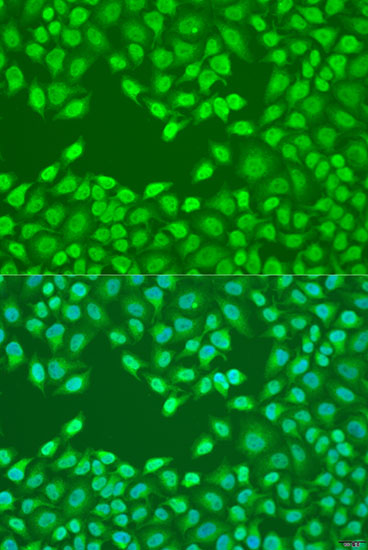-
Product Name
FZD4 Polyclonal Antibody
- Documents
-
Description
Polyclonal antibody to FZD4
-
Tested applications
IF
-
Species reactivity
Human
-
Alternative names
FZD4 antibody; CD344 antibody; EVR1 antibody; FEVR antibody; FZD4S antibody; Fz-4 antibody; Fz4 antibody; FzE4 antibody; GPCR antibody; hFz4 antibody; frizzled-4 antibody
-
Isotype
Rabbit IgG
-
Preparation
Antigen: Recombinant fusion protein containing a sequence corresponding to amino acids 37-222 of human FZD4 (NP_036325.2).
-
Clonality
Polyclonal
-
Formulation
PBS with 0.02% sodium azide, 50% glycerol, pH7.3.
-
Storage instructions
Store at -20℃. Avoid freeze / thaw cycles.
-
Applications
IF 1:50 - 1:200
-
Validations

Immunofluorescence - FZD4 Polyclonal Antibody
Immunofluorescence analysis of U2OS cells using FZD4 antibody at dilution of 1:100. Blue: DAPI for nuclear staining.
-
Background
Receptor for Wnt proteins. Most of frizzled receptors are coupled to the beta-catenin (CTNNB1) canonical signaling pathway, which leads to the activation of disheveled proteins, inhibition of GSK-3 kinase, nuclear accumulation of beta-catenin (CTNNB1) and activation of Wnt target genes. Plays a critical role in retinal vascularization by acting as a receptor for Wnt proteins and norrin (NDP). In retina, it can be both activated by Wnt protein-binding, but also by a Wnt-independent signaling via binding of norrin (NDP), promoting in both cases beta-catenin (CTNNB1) accumulation and stimulation of LEF/TCF-mediated transcriptional programs. A second signaling pathway involving PKC and calcium fluxes has been seen for some family members, but it is not yet clear if it represents a distinct pathway or if it can be integrated in the canonical pathway, as PKC seems to be required for Wnt-mediated inactivation of GSK-3 kinase. Both pathways seem to involve interactions with G-proteins. May be involved in transduction and intercellular transmission of polarity information during tissue morphogenesis and/or in differentiated tissues.
Related Products / Services
Please note: All products are "FOR RESEARCH USE ONLY AND ARE NOT INTENDED FOR DIAGNOSTIC OR THERAPEUTIC USE"
